cmp_adv_ch00 中山大学吴柏林教授《广告策划:实务与案例》机械工业出版社2010年版
中山大学吴柏林教授,基于消费者洞察的广告策略,绝密资料,网络视频版_02b
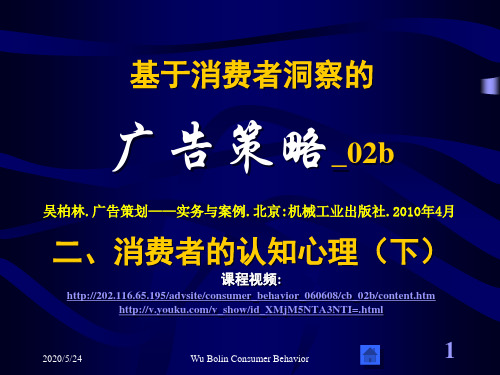
2010-10-10
Wu Bolin Consumer Behavior
24
联觉: 联觉: 由一种已经产生的感觉引起另一 种感觉的心理现象。 种感觉的心理现象。 视觉 嗅觉 听觉
触觉
2010-10-10
味觉
Wu Bolin Consumer Behavior
25
联觉: 味道看得见?
2010-10-10
Wu Bolin Consumer Behavior
26
冷酸灵 柠檬 想吃就吃
2010-10-10 Wu Bolin Consumer Behavior
27
冷酸灵 相声 冷热酸甜
2010-10-10 Wu Bolin Consumer Behavior
28
Airwaves 视觉表达味觉
2010-10-10 Wu Bolin Consumer Behavior
2010-10-10
Wu Bolin Consumer Behavior
7
父子俩住在山上,每天都要赶牛车下山卖柴。 父亲较有经验,坐镇驾车,山路崎岖,弯道特 多,儿子眼神较好,总是在要转弯时提醒道: “爹,转弯啦!” 有一次父亲因病没有下山,儿子一人驾车。到 了弯道,牛怎么也不肯转弯,儿子用尽各种方 法,下车又是推来又拉,还用青草诱之,牛仍 然一动不动。 到底是怎么回事?儿子百思不得其解。最后只 有一个办法了… 他左右看看无人,贴近牛的耳朵大声叫道:“ 爹,转弯啦!”,牛便应声而动了。
时间(周) 时间( 22
( 四)想象
表象 想象 联觉 联想
23
2010-10-10
Wu Bolin Consumer Behavior
表象: 表象: 销售主题的心理素材 想象: 想象: 无意想象 有意想象
中山大学吴柏林教授,基于消费者洞察的广告策略,绝密资料,网络视频版_04

9
东亚银行 扶老人过马路 2000
2013-8-4 Wu Bolin Consumer Behavior
10
东亚银行 为孕妇拦的士 1999
2013-8-4 Wu Bolin Consumer Behavior
11
高贵 华架山一号 0302
2013-8-4 Wu Bolin Consumer Behavior
29
KFC 肯德基 分享 0209
2013-8-4
Wu Bolin Consumer Behavior
30
KFC 肯德基 祁宏到我家 0212
2013-8-4 Wu Bolin Consumer Behavior
31
11-015 Levis501 裤之牵引
2013-8-4 Wu Bolin Consumer Behavior
2013-8-4
Wu Bolin Consumer Behavior
5
情 感 与 情 绪 的 两 极 性
愤怒 警戒 憎恨 悲伤
狂喜 接受 惊愕 恐怖
6
2013-8-4
Wu Bolin Consumer Behavior
情 感 与 情 绪 的 强 度 及 相 似 性
2013-8-4
警戒 憎恨 悲伤 恐怖 惊愕
2013-8-4
Wu Bolin Consumer Behavior
1
对消费者行为的深层把握
一、消费者的动机与需求_ 二、消费者的认知心理_ 三、消费者的态度与说服心理_ 四、消费者的情感与情绪_ 五、消费者的自我意识_
2013-8-4
Wu Bolin Consumer Behavior
2
四、消费者的情感与情绪
对商业广告的伦理思考,中山大学吴柏林教授,广告策划:实务与案例,机械工业出版社,2010年版
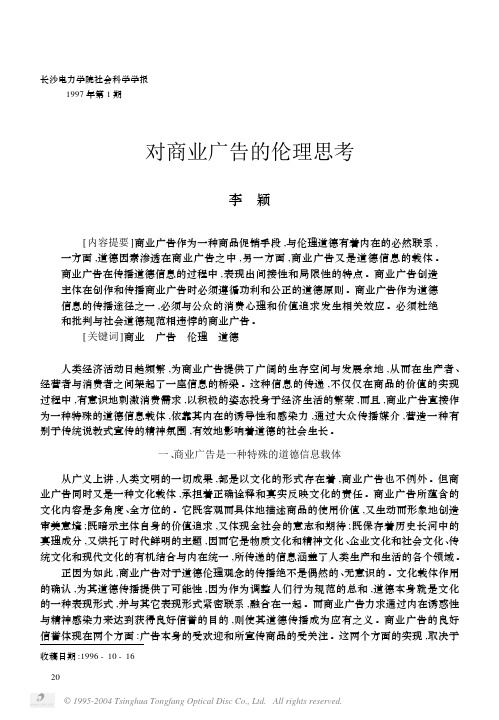
长沙电力学院社会科学学报 1997年第1期对商业广告的伦理思考李 颖[内容提要]商业广告作为一种商品促销手段,与伦理道德有着内在的必然联系,一方面,道德因素渗透在商业广告之中,另一方面,商业广告又是道德信息的载体。
商业广告在传播道德信息的过程中,表现出间接性和局限性的特点。
商业广告创造主体在创作和传播商业广告时必须遵循功利和公正的道德原则。
商业广告作为道德信息的传播途径之一,必须与公众的消费心理和价值追求发生相关效应。
必须杜绝和批判与社会道德规范相违悖的商业广告。
[关键词]商业 广告 伦理 道德人类经济活动日趋频繁,为商业广告提供了广阔的生存空间与发展余地,从而在生产者、经营者与消费者之间架起了一座信息的桥梁。
这种信息的传递,不仅仅在商品的价值的实现过程中,有意识地刺激消费需求,以积极的姿态投身于经济生活的繁荣,而且,商业广告直接作为一种特殊的道德信息载体,依靠其内在的诱导性和感染力,通过大众传播媒介,营造一种有别于传统说教式宣传的精神氛围,有效地影响着道德的社会生长。
一、商业广告是一种特殊的道德信息载体从广义上讲,人类文明的一切成果,都是以文化的形式存在着,商业广告也不例外。
但商业广告同时又是一种文化载体,承担着正确诠释和真实反映文化的责任。
商业广告所蕴含的文化内容是多角度、全方位的。
它既客观而具体地描述商品的使用价值,又生动而形象地创造审美意境;既暗示主体自身的价值追求,又体现全社会的意志和期待;既保存着历史长河中的真理成分,又烘托了时代鲜明的主题,因而它是物质文化和精神文化、企业文化和社会文化、传统文化和现代文化的有机结合与内在统一,所传递的信息涵盖了人类生产和生活的各个领域。
正因为如此,商业广告对于道德伦理观念的传播绝不是偶然的、无意识的。
文化载体作用的确认,为其道德传播提供了可能性,因为作为调整人们行为规范的总和,道德本身就是文化的一种表现形式,并与其它表现形式紧密联系,融合在一起。
而商业广告力求通过内在诱惑性与精神感染力来达到获得良好信誉的目的,则使其道德传播成为应有之义。
中山大学吴柏林教授“广告策划——实务与案例”绝密资料_KOTLER09
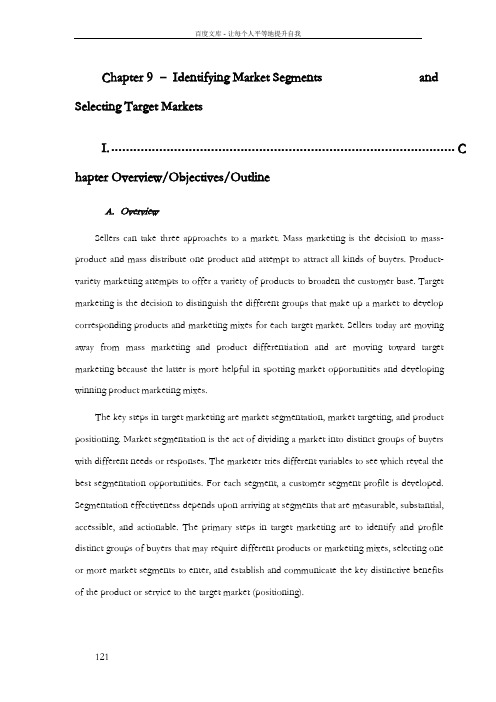
Chapter 9 – Identifying Market Segments and Selecting Target MarketsI.............................................................................................. C hapter Overview/Objectives/OutlineA.OverviewSellers can take three approaches to a market. Mass marketing is the decision to mass-produce and mass distribute one product and attempt to attract all kinds of buyers. Product-variety marketing attempts to offer a variety of products to broaden the customer base. Target marketing is the decision to distinguish the different groups that make up a market to develop corresponding products and marketing mixes for each target market. Sellers today are moving away from mass marketing and product differentiation and are moving toward target marketing because the latter is more helpful in spotting market opportunities and developing winning product marketing mixes.The key steps in target marketing are market segmentation, market targeting, and product positioning. Market segmentation is the act of dividing a market into distinct groups of buyers with different needs or responses. The marketer tries different variables to see which reveal the best segmentation opportunities. For each segment, a customer segment profile is developed. Segmentation effectiveness depends upon arriving at segments that are measurable, substantial, accessible, and actionable. The primary steps in target marketing are to identify and profile distinct groups of buyers that may require different products or marketing mixes, selecting oneor more market segments to enter, and establish and communicate the key distinctive benefitsof the product or service to the target market (positioning).The seller should target the best market segment(s). The seller must evaluate the potentialof each segment, which is a function of segment size and growth, segment attractiveness, and company objectives and resources. Then, the seller should determine how and when it can ignore segment differences (undifferentiated marketing), develop different market offers for several segments (differentiated marketing), or go after one or a more market segments (concentrated marketing). In choosing target segments, marketers need to consider the ethical choice of market targets, segment interrelationships and super segments, and potential segment invasion plans.B.Learning Objectives............................................................................................................................. U nderstand what it means to “segment” a market.............................................................................................................................. K now the basic steps in segmenting a market.............................................................................................................................. U nderstand the bases used to segment consumer and business markets.............................................................................................................................. K now how to evaluate and select segments for targeting of marketing programs.C.Chapter OutlineI (I)ntroduction - Target marketing requires the following: identify and profile distinctgroups of buyers with distinct needs/preferences, select one or more market segments,establish and communicate distinctive benefits of the market offering to each targetsegment.II.................................................................................................................... U sing Market Segmentation - Buyers differ in many ways.ntroduction1............................................................................................... Mass Marketing - One product/marketing mix available for all buyers.2............................................................................................... Micro Marketing - The response to the decline in favor for massmarketing.B. ........................................................................................................ S egment marketing - A large identifiable group within a market. Midpoint between mass and individual marketing.C. ........................................................................................................ N iche Marketing - A narrowly defined smaller group whose needs not currently met effectively.D......................................................................................................... L ocal Marketing - Programs targeted to the needs and wants of local customer groups.E (I)ndividual Marketing - “One-to-One” Marketing1............................................................................................... Mass-customization and choice board2............................................................................................... Customerization - Empowering customers with the means to design theirown products.atterns of Market Segmentation - homogenous, diffused, and clusteredpreferencesG......................................................................................................... Market Segmentation Process - survey, analysis, and profile1............................................................................................... Focus on needs-based market segmentation and market partitioning.H......................................................................................................... Effective Segmentation - Segments must be measurable, substantial, accessible,differentiable, and actionable.III. ................................................................................................................. Segmenting Consumer and Business MarketsA......................................................................................................... Bases for Segmenting Consumer Markets:1............................................................................................... Geographic - nations, states, regions, counties, cities, and neighborhoods2............................................................................................... Demographic - age and life cycle, gender, income, generation, and socialclass.3............................................................................................... Psychographic - lifestyle, personality, and values4............................................................................................... Behavioral - purchase occasions, benefits, user status, usage rate, loyaltystatus, buyer-readiness stage, and attitude5............................................................................................... Multiattribute Segmentation (geoclustering): Assumes people who livenear each other and exhibit similar traits from all of the abovesegmentation bases.a) ................................................................................... Targeting Multiple Segments - Because consumers no longer canbe neatly pigeonholed into one segment.b)................................................................................... Geoclustering via PRIZM clusters (American dreams, ruralindustria, gray power, country squires) - Focus on increasingdiversity.B. ........................................................................................................ Bases for Segmenting Business Markets1............................................................................................... Based on their stage in the purchase decision process and channelpreferences.2............................................................................................... Types of buyers: programmed, relationship, transaction, and bargainhunters3............................................................................................... Business buyer groups: price-oriented (transactional selling), solutionoriented (consultative selling), and strategic value (enterprise selling)IV.Market Targeting StrategiesA......................................................................................................... Evaluating and selecting the market segments. Factors: Segment size and growth,segment structural attractiveness, company objectives, and resources.1............................................................................................... Single-Segment Concentration - Firm concentrates on one market onlyfor its one product.2............................................................................................... Selective Specialization - Firm selects a number of attractive andappropriate segments and develops products that appeal to eachsegment.3............................................................................................... Product Specialization - Firm focus is on a product it can sell to severalsegments.4............................................................................................... Market Specialization - Firm satisfies multi-faceted needs of oneparticular group.5............................................................................................... Full Market Coverage - Firm serves all customer groups with productsthey might need.a) ................................................................................... Undifferentiated Marketing - Entire market receives the sameprogram.b)................................................................................... Differentiated Marketing - Different programs for differentsegments.B. ........................................................................................................ T argeting Multiple Segments and Super segments - use of mega marketingC. ........................................................................................................ E thical Choice of Market Targets - targeting sometimes generates controversyV.................................................................................................................... S ummaryII. Lecture“Understanding Market Segments”This discussion begins the teaching/learning process where students begin to understand that marketing and marketers cannot be all things to all people, and there is a need for increasing focus and segmentation.Teaching Objectives........................................................................................................................ T o appreciate the value of segmenting and targeting markets......................................................................................................................... T o comprehend the process through which marketers engage in segmentation......................................................................................................................... T o learn about companies/industries making use of segmentation.DiscussionU NDERSTANDING THE I SSUEMarket segmentation is a process based on factual information rather than marketer intuition. The value of market segmentation is obvious. Customers are different and are likelyto be attracted to different products throughout various stages in their lifetimes. For an illustration of this concept, consider the automobile industry.Note to the Instructor: To develop this issue, ask students to offer the names of various brands and models (placed on the board). Then, ask them to identify which brands and modelsare likely to appeal to specific characteristics - age, income, gender, etc. From this illustration, it will become obvious that not all products appeal to everyone on a mass level.The segmentation process involves dividing a market into distinct groups of buyers who might require separate products or marketing mixes, recognizing that all buyers have unique needs and wants. Still, it is usually possible in consumer markets to identify relatively homogeneous portions or segments of the total market according to shared preferences, attitudes, or behaviors that distinguish them from the rest of the market. These segments may require different products and/or separate mixes, and in the contemporary one-to-one marketing approach segmentation is a critical step.T ARGETING AND P OSITIONINGMarket targeting is the follow-up to the segmentation process and is the process of evaluating each market segment’s attractiveness and selecting one or more segments to enter. Given effective market segmentation, the firm must choose which markets to serve and howto serve them. In targeting markets to serve, the firm must consider its resources and objectives in setting strategy.Market positioning is the process of formulating competitive positioning for a product and a detailed marketing mix. The firm must have a plan for how to present the product to the consumer, and the product’s position is defined by how consumers view it on important attributes. The text discusses this concept in detail.The consumer market is often segmented according to variables such as: demographics, psychographics, geographic location, behavior, etc. Major segmentation variables for business markets obviously vary from the consumer market. The important variables here are as follows:........................................................................................................ D emographics. Industry segmentation focuses on which industries buy theproduct. Company size can be used. Geographic location may be used togroup businesses by proximity......................................................................................................... O perating Variables. Business markets can be segmented by technology (whatcustomer technologies should we focus on?), user/nonuser status (heavy,medium, light), or customer capabilities (those needing many or few services)......................................................................................................... P urchasing Approaches. Five approaches are possible:o............................................................................................... S egment. “Segmentation” can be by purchasing function organ ization(centralized or decentralized).o............................................................................................... P ower structure. Selecting companies controlled by a functional specialty.o............................................................................................... T he Nature of Existing Relationships. Current desirable customers ornew desirable customers.o............................................................................................... G eneral Purchase Policies.Focus on companies that prefer somearrangements over others such as leasing, related support servicecontracts, sealed bids.o............................................................................................... P urchasing Criteria.Focus on non-compensatory criteria such as price,service, or quality.In addition, there can be situational factors that influence the business market segmentation effort. Situational segmentation may be based upon urgency (such as quickdelivery needs), specific application (specific uses for the product) or size of order (few large or many small accounts).PERSONAL CHARACTERISTICSPersonal comparisons can lead to segmentation by buyer-seller similarity (companies with similar personnel and values), attitudes toward risk (focus on risk-taking or risk-avoiding companies), or loyalty (focus on companies that show high loyalty to their suppliers).There are several steps in the segmentation and target marketing process, but first it is necessary to establish that the market can be segmented. As mentioned in the text, some of the questions a company should answer with regard to determining candidates for segmentation are:........................................................................................................ C an the market(s) be identified and measured? (I)s the segment large enough to be profitable? Related issue: Is the segmentstable and long-term? (I)s the segment reachable? (I)s the segment responsive? (I)s the segment expected not to change quickly?........................................................................................................ C an the segment be protected (protectability)? In other words, can competitorschoose to target this segment easily and with a high level of success (I)nteraction with other segments? Meaning: Will the different messages receivedcause confusion about the product among different segments?........................................................................................................ W hat is the risk with this segment or segmentation action?F INDING “H EALTHY”C USTOMERS IN THE M EDICALI NDUSTRYAs members of its industry begin to understand the mass-market approach is no longer viable, health care providers are moving from a product orientation to a marketing orientation. Market segmentation has become a tool that is widely used by a financially squeezed health care industry. Aiming their marketing efforts at those segments of the market that are likely to prove most profitable helps to conserve their limited resources. Some of the characteristics health care providers use to choose the proper target markets include underlying needs, demographics, and patterns of behavior.Because hospitals maintain detailed information on patients, the information necessary to determine the “typical” patient is available. Through medical and business records, health care marketers have access to usage rates for a predetermined number of years, services received, payment (or nonpayment) history, and, at the simplest level, name and address information. The search for data also can extend to external sources, such as state agencies, trade associations, and syndicated sources. Once the marketer has gathered this data, he or she can begin the process of analyzing it to determine market share for the various lines of health care services.Overlaying demographic with psychographic information allows hospitals to learn aboutthe people who compose the market. By combining this information with its own product line mix, and disease incidence rates, segmentation opportunities become readily apparent. For example, one hospital recently recognized the potential for outpatient substance-abuse counseling services among upscale members of the business community. Although acompetitor currently offered an in-patient program, the target group most likely to utilize the service found the in-patient option unappealing for many reasons, one of which was that many potential patients lived in close proximity to the hospital.Based on an understanding of its target market, the marketing-oriented hospital developed an outpatient program and spoke directly to the target audience via promotional efforts in publications and television. A direct mail effort also targeted the businesses where those upscale patients were likely to be found. As a result, the hospital gained significant market share and won the favor of the community. This was no small feat in today’s competitive health care marketplace.S ENIOR C ITIZENS E NJOY S URFING…T HE I NTERNETMany members of the older generation are out to dispel beliefs that they are resistant to new technology. Internet clubs, consisting of members who are in their later years, have been formed all over the United States. The seniors use the Internet to obtain many types of new information, order products, and meet and/or “chat” with other seniors throughout the country. A number of marriages have evolved out of these connections.Smart marketers realize that this segment of the market represents a substantial audience for products advertised via the Internet. Why? One reason is the information explosion. Consider the amount of information that is available on the Internet. In today’s society, few of us in the work force have the leisure time available to spend learning about the power of the Internet. We tend to bookmark the information we need on a regular basis but rarely venture out on exten sive “surfing” expeditions. Retired persons do have this kind of time, so when they log on to the Internet, they are likely to stay a while. In addition, many of the people in their golden years have physical limitations that may restrict their mobility. The Internet is an ideal way to stay connected to the outside world and beat the loneliness that may ensue from an inability to venture beyond their home.Note to the Instructor: It is important to note here that when a marketer considers the needs of one segment over all other segments, controversy is likely to ensue. A good way to begin a discussion in this topic area is to ask students for some of the dangers and/or disadvantages that may result from segmenting and targeting markets.III................................................................................................... Background ArticleIssue: Gaining Perspective On Niche Market SegmentsSource: “RTD Coffee: The Little Segment That Could -Convenience Corner,” Beverage Aisle, October 15, 2001, p. 48.Ready-to-drink coffee (RTD), the cold, refreshing, bottled offshoot of America’s classic hot morning beverage, has found a home in the convenience channel. An up-and-coming category, RTD coffee generated less than $50 million at retail in 1996, but soared to over $100 million in 1997, driven by Frappuccino from Starbucks/PepsiCo, which still owns most of the category.Today, while the bottled variety represents a tiny fraction of the overall coffee category (3 percent of total coffee sold in grocery, drug, and mass merchandisers combined), an analysis of ACNielsen Convenience Track data shows that the product is selling especially well in convenience stores (c-stores). The convenience channel owns 38 percent of the $175 million segment on a four-channel basis. But while the segment is up just percent in grocery, percentin dr ug, and down over 16 percent in mass, it’s up percent in the convenience channel.What accounts for that growth? Part of it may be explained by the product’s appeal to teens and young adults, who prefer to get their caffeine from a cold drink. The product comesin sweet flavors such as mocha and caramel. We know that families with teenagers account for21 percent of the dollars spent on the bottled coffee category across all channels, whereas they account for just percent of the population—for a dollar volume index of 137. Because kids are frequent shoppers in c-stores, they may account for some of the c-store volume.But kids aren’t the only consumer group fueling RTD coffee growth. The product indexes high with households that are affluent (dual-earners, well educated, employed in white-collar professions) and urban, segments that do not traditionally shop in c-stores as much as their counterparts. The result is an opportunity for convenience retailers to attract new customers to their stores at a time when they could certainly use some.Based on an analysis of ACNielsen Homescan consumer panel data, c-stores have experienced a decline in shopping penetration, sliding from 52 percent of the population in 1998 to 48 percent in 2000. Other channels have been chipping away at the convenience channel’s main selling proposition, with grocers installing gas pumps and drug stores and selling more food (earning the moniker “the convenience store for women”), video stores selling candy and soft drinks, and everyplace, from coffee shops to clothing stores, selling mints.Perhaps convenience store operators could use the RTD coffee segment to target more affluent consumers. If the strategy succeeds, it won’t be just the consumers who get a boost from the product.RTD Coffee Sales by Channel $174,617,058 (*)Change from One YeAgo (%)Grocery+Convenience+Drug(*)Source: ACNielsen Convenience Track, 52 wks ending 8/4/01. Grocery, Drug, Convenience combined.IV.CaseEastman Kodak Co., Funtime FilmHBS Case: 594-111 TN: 5-597-080Teaching PerspectivesThis is a rather short case, and the issues are fairly clear, leaving time for students to undertake in-depth analysis. It could also be used in the pricing module of a marketing management course since the issue of whether to take a price cut your flagship brand instead of proliferating the line is important. Because of the magnitude of the market issuch that one (1) share point in the market is worth $13 million in gross margin dollarsper year to Kodak, it captures student interest. The profitability of the business declinedby about $80 million during the last five years. Thus, Kodak must “do something”but figuring out a viable plan for stemming the share loss without loss in profitability is a challenge.While Eastman Kodak still maintained a dominant position in the . film market in 1993, its share had declined to 70 percent from 76 percent only five years earlier. This erosion was at the hands of Fuji, which held the No. 2 position at 11 percent share, andprivate label suppliers. Some observers felt the film industry had become more commodity-like as actual performance differences between brands became insignificant. To deal with this eroding share position, Kodak management prepared to launch a “fighting brand” called Funtime to compete with less expensive rivals. Funtime would involve a vertical product line proliferation strategy whereby Kodak would offer a “good, better, best” selection of films for amateur users. The case sets out the market situation and the proposed Funtime strategy. The discussion focuses on diagnosing the source of Kodak’s problems, establishing realistic objectives for the film business going forward, evaluating the Funtime strategy and developing an alternative action plan if the Funtime strategy should fail.The case is designed to:Allow students to ascertain the forces underlying amarket’s move to commodity status producing share pressure on thehigh priced offerings in the market.Expose students to the “fighting brand” strategy and more generally the issues involved in managing vertical product lineproliferation, . “good, better, best” strategies.P rovide opportunity for quantitative analysis, such as margin calculations and break-even analysis, in assessing marketing strategy.Provide a setting in which to analyze the importance of a “brand name” in consumers’ decision making and how that mayvary by customer segment, usage occasion and over time.Analysis of the case has four major parts:1.......................................................................................................... Diagnosis of th e reasons for Kodak’s market share loss and assessment oflikely development of the market if Kodak maintained the status quo.2.......................................................................................................... Specification of what Kodak’s objectives ought to be at this point. Thisinvolves possible trade-offs between market share, profitability and brandequity.3.......................................................................................................... Evaluation of the general concept of Funtime proposal and its implementationdetails given consumer behavior.4.......................................................................................................... Consideration of other action plan options such as a price cut on the flagshipGold Plus brand.There are a number of reasons for the market share shift, but they basically all revolve around the idea that the added value that Kodak delivers to consumers, relative to competitors, has declined over time, while Kodak has maintained its 17 percent price premium over Fuji and 30 percent over private label brands. The reasons can be set out along customer, competitor, and company lines. The reason is that customers “tend to view film as a commodity, often buying on price alone. Accordingly, there is a growing body of price-sens itive consumers.”Evaluating the competition in the film category, the competitors are growing and succeeding. Fuji is growing in reputation and acceptance in the . market and Polaroid, a well-known entrant into the conventional film market, is operating at low prices. In addition, private label film is becoming more acceptable and no longer perceived as low quality.Questions:。
经济广告伦理思想浅析,中山大学吴柏林教授,广告策划:实务与案例,机械工业出版社,2010年版,绝密教学资料

江西省团校学报2000年第2期学术探讨经济广告伦理思想浅析邓少海罗蔚经济广告,是指除政治、文化广告,社会公益广告等广告之外的商业性广告,特指企业为推销其产品而进行的并要支付一定报酬的宣传推介活动。
它作为商品经济和社会发展的产物,是社会进步的一种标志。
随着信息时代的到来,经济广告日益成为人们生活中不可或缺的一部分,并以其纷繁复杂的面貌感性地存在着。
本文力求对这些感性的经济广告作更深层的理性思考,找出其以特殊形式折射出的伦理道德思想。
一、从宏观层面透视经济广告中的伦理内涵11经济广告潜在的道德价值导向作用经济广告的功能是传播信息、宣传产品。
它在宣传产品时,具有强烈的导向性。
它总是试图改变或引导人们的消费行为,劝诱人们放弃旧的消费观念,接受新的消费观念。
消费者在选择一种消费行为时,其消费活动在一定程度上显示出他本身的一种生活的理想和价值的追求。
因为人们在满足低层次的生存需求之后,就必然有更高层次的理想、价值的需求,这种需求的满足有时也反映在人们的消费行为和消费观念上:如在生活中总是把钱消费在学习进步上或总是把钱消费在生活享乐上的人,其人生价值取向就明显不同。
虽然“书和酒的价格可能一样,但价值却大大的不同”,由此可看出不同的消费行为反映出消费者的价值观不同。
所以,经济广告不仅仅可以获取经济效益,还会产生较广泛的社会效益。
在经济广告进行产品宣传时,它同时还宣传着一种意识形态,一种价值取向和生活态度。
纵观近年来,一些经济广告中竞相出现的把产品与“皇室”、“王朝”拉上关系的现象,即在宣传产品时,此种广告还宣扬一种“帝王享受”和“豪门气派”的思想,这不免给其产品附加上一种“等级观念”。
而在各电视台纷纷上演的“电视购物”的版块栏目中,有的经济广告更是以低水平的表演和迷惑性的广告语言推销着昂贵的产品,着力渲染一种物质享受给人们带来的所谓“幸福”,实质上给人们示范的是享受奢侈的生活方式,并倡导一种盲目的高消费,要人们接受一种“人活着就是为了享受”的人生哲学。
市场伦理的经济学分析,中山大学吴柏林教授,广告策划:实务与案例,机械工业出版社,2010年版,绝密教学资料
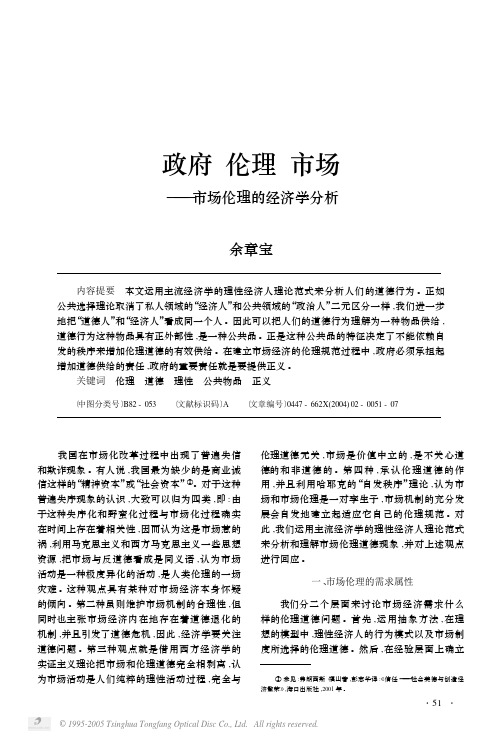
关键词 伦理 道德 理性 公共物品 正义
〔中图分类号〕B82 - 053 〔文献标识码〕A 〔文章编号〕0447 - 662X(2004) 02 - 0051 - 07
我国在市场化改革过程中出现了普遍失信 和欺诈现象 。有人说 ,我国最为缺少的是商业诚 信这样的“精神资本”或“社会资本”①。对于这种 普遍失序现象的认识 ,大致可以归为四类 ,即 :由 于这种失序化和野蛮化过程与市场化过程确实 在时间上存在着相关性 ,因而认为这是市场惹的 祸 ,利用马克思主义和西方马克思主义一些思想 资源 ,把市场与反道德看成是同义语 ,认为市场 活动是一种极度异化的活动 ,是人类伦理的一场 灾难 。这种观点具有某种对市场经济本身怀疑 的倾向 。第二种虽则维护市场机制的合理性 ,但 同时也主张市场经济内在地存在着道德退化的 机制 ,并且引发了道德危机 ,因此 ,经济学要关注 道德问题 。第三种观点就是借用西方经济学的 实证主义理论把市场和伦理道德完全相剥离 ,认 为市场活动是人们纯粹的理性活动过程 ,完全与
在这两种方式中 , 第一种中签方式是一种 “纯粹的自利型”或“浮士德式”② 的行为模式 ,即 为了自己的利益都有权杀死对方 ,这种方式对应 于那些极端自私自利 、不择手段之徒 。第二种方 式就是那种“毫不利己 、专门利人”的“纯粹的利 他型”或“仁爱”的行为模式 ,即为了他人可以奉 献和牺牲自己的一切 ,博爱的上帝或仁爱的圣人 就代表了这一类典型 。假如双方都是“极端自私 型”,由于这两个人是完全势均力敌的 ,显而易见 两者火并的结果必然是两者都毁灭 。相反 ,假如 这两位都是“纯粹利他型”的圣人 ,那将出现什么 结局呢 ? 既然他们都是圣人 ,他们中就没有一个 人能接受另一个人的牺牲 。因为如果接受他人 的牺牲 ,那么他自己就已经不是一位圣人 。因而 两个圣人选择应该都是自我牺牲 。
略论商业广告的伦理原则,中山大学吴柏林教授,广告策划:实务与案例,机械工业出版社,2010年版,绝密教学资料

1999年 第6期中山大学学报论丛S UPP LE ME NT T O THE JOURNA LOF S UN Y ATSE N UNI VERSITY N o16 1999 略论商业广告的伦理原则冯益谦 邹木兰随着社会主义市场经济的深入发展,人们已不知不觉地置身于广告的海洋之中。
不论你喜欢与否,广告总是以独特的方式,成为影响人们经济生活和精神生活的重要因素。
可是,在现实生活中,一些人为了获取最大利润,在商业广告中不时出现一些非道德行为,不但使消费者上当受骗,而且还污染了社会风气,对社会主义精神文明建设产生了不良的影响。
因此,大力提倡商业广告道德,对于促进两个文明建设,有着迫切的现实意义。
笔者认为,在当前商业广告宣传中,要注意遵循下列三条伦理原则。
(一)真实性原则广告是严肃的职业。
实事求是,真实地反映商品的本来面貌,是商业广告的生命,也是企业的生命。
所谓真实性原则,就是有一说一,有二说二,恰如其分地反映商品面貌,既不增大优点,也不缩小缺点,不故弄玄虚,不哗众取宠。
事实上,任何商品在款式、规格上都各有优点和缺点,对优点、缺点都要实事求是地介绍。
即使在资本主义社会中,不少企业、公司为了在社会上站稳脚根,以求发展,也都把广告真实性作为重要原则。
如以广告宣传为手段驰名世界的柯达(K odak)、可口可乐(C ocaC ola)等都十分注重商品宣传的真实性。
他们反对说假话,批判那种认为言过其实的广告是“无害的夸张”的观点,并禁止商业组织作带欺骗性的广告。
在社会主义市场经济条件下,我们更要自觉遵循商业广告宣传中的真实性原则。
然而,在当今漫天的商品广告中,失真的广告屡见不鲜。
有些谎话连篇,滥提口号,不讲分寸;把劣质产品吹嘘为“优质产品”;工艺不高的称为“全国先进”;本来不受欢迎的,也宣传是“畅销国内外”。
如1998年下半年,“学习的革命”的图书广告铺天盖地,风靡中国。
该广告称:这本书带来了学习的革命!这是一部卓有见识的行动指南,读了它会改变孩子一生的命运,就能拿到通向21世纪的个人护照。
王启义 商业伦理,中山大学吴柏林教授,广告策划:实务与案例,机械工业出版社,2010年版,绝密教学资料
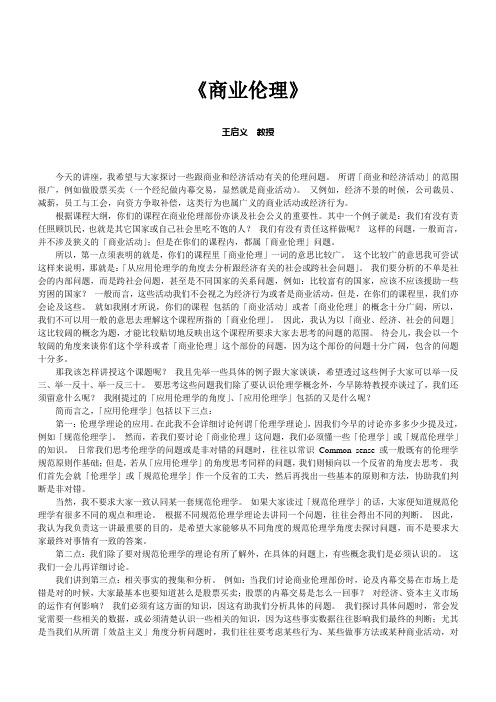
《商业伦理》王启义教授今天的讲座,我希望与大家探讨一些跟商业和经济活动有关的伦理问题。
所谓「商业和经济活动」的范围很广,例如做股票买卖(一个经纪做内幕交易,显然就是商业活动)。
又例如,经济不景的时候,公司裁员、减薪,员工与工会,向资方争取补偿,这类行为也属广义的商业活动或经济行为。
根据课程大纲,你们的课程在商业伦理部份亦谈及社会公义的重要性。
其中一个例子就是:我们有没有责任照顾饥民,也就是其它国家或自己社会里吃不饱的人?我们有没有责任这样做呢?这样的问题,一般而言,并不涉及狭义的「商业活动」;但是在你们的课程内,都属「商业伦理」问题。
所以,第一点须表明的就是,你们的课程里「商业伦理」一词的意思比较广。
这个比较广的意思我可尝试这样来说明,那就是:「从应用伦理学的角度去分析跟经济有关的社会或跨社会问题」。
我们要分析的不单是社会的内部问题,而是跨社会问题,甚至是不同国家的关系问题,例如:比较富有的国家,应该不应该援助一些穷困的国家?一般而言,这些活动我们不会视之为经济行为或者是商业活动,但是,在你们的课程里,我们亦会论及这些。
就如我刚才所说,你们的课程_包括的「商业活动」或者「商业伦理」的概念十分广阔,所以,我们不可以用一般的意思去理解这个课程所指的「商业伦理」。
因此,我认为以「商业、经济、社会的问题」这比较阔的概念为题,才能比较贴切地反映出这个课程所要求大家去思考的问题的范围。
待会儿,我会以一个较阔的角度来谈你们这个学科或者「商业伦理」这个部份的问题,因为这个部份的问题十分广阔,包含的问题十分多。
那我该怎样讲授这个课题呢?我且先举一些具体的例子跟大家谈谈,希望透过这些例子大家可以举一反三、举一反十、举一反三十。
要思考这些问题我们除了要认识伦理学概念外,今早陈特教授亦谈过了,我们还须留意什么呢?我刚提过的「应用伦理学的角度」、「应用伦理学」包括的又是什么呢?简而言之,「应用伦理学」包括以下三点:第一:伦理学理论的应用。
中山大学吴柏林教授 “广告策划——实务与案例”绝密资料_KOTLER17
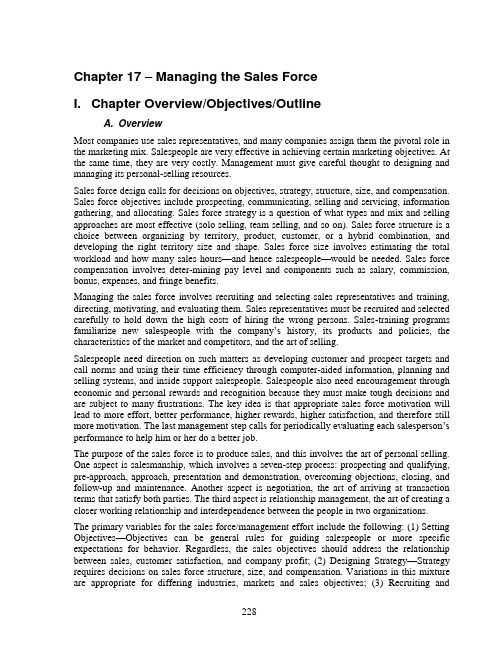
Chapter 17 – Managing the Sales ForceI. Chapter Overview/Objectives/OutlineA. OverviewMost companies use sales representatives, and many companies assign them the pivotal role in the marketing mix. Salespeople are very effective in achieving certain marketing objectives. At the same time, they are very costly. Management must give careful thought to designing and managing its personal-selling resources.Sales force design calls for decisions on objectives, strategy, structure, size, and compensation. Sales force objectives include prospecting, communicating, selling and servicing, information gathering, and allocating. Sales force strategy is a question of what types and mix and selling approaches are most effective (solo selling, team selling, and so on). Sales force structure is a choice between organizing by territory, product, customer, or a hybrid combination, and developing the right territory size and shape. Sales force size involves estimating the total workload and how many sales hours—and hence salespeople—would be needed. Sales force compensation involves deter-mining pay level and components such as salary, commission, bonus, expenses, and fringe benefits.Managing the sales force involves recruiting and selecting sales representatives and training, directing, motivating, and evaluating them. Sales representatives must be recruited and selected carefully to hold down the high costs of hiring the wrong persons. Sales-training programs familiarize new salespeople with the company‘s history, its products and policies, the characteristics of the market and competitors, and the art of selling.Salespeople need direction on such matters as developing customer and prospect targets and call norms and using their time efficiency through computer-aided information, planning and selling systems, and inside support salespeople. Salespeople also need encouragement through economic and personal rewards and recognition because they must make tough decisions and are subject to many frustrations. The key idea is that appropriate sales force motivation will lead to more effort, better performance, higher rewards, higher satisfaction, and therefore still more motivation. The last management step calls for periodically evaluating each salesperson‘s performance to help him or her do a better job.The purpose of the sales force is to produce sales, and this involves the art of personal selling. One aspect is salesmanship, which involves a seven-step process: prospecting and qualifying, pre-approach, approach, presentation and demonstration, overcoming objections, closing, and follow-up and maintenance. Another aspect is negotiation, the art of arriving at transaction terms that satisfy both parties. The third aspect is relationship management, the art of creating a closer working relationship and interdependence between the people in two organizations. The primary variables for the sales force/management effort include the following: (1) Setting Objectives—Objectives can be general rules for guiding salespeople or more specific expectations for behavior. Regardless, the sales objectives should address the relationship between sales, customer satisfaction, and company profit; (2) Designing Strategy—Strategy requires decisions on sales force structure, size, and compensation. Variations in this mixture are appropriate for differing industries, markets and sales objectives; (3) Recruiting andSelecting—Knowing in advance what characteristics will always produce good salespeople is very difficult. Selection procedures should screen candidates for both ability and retention-related issues; (4) Training Salespeople—Issues in training center on skills such as order taking, order getting, and seeing customers as people who require problem solutions; (5) Supervising Salespeople—Supervis ion addresses problems in directing and coordinating salespeople‘s organization, time management, motivation, and customer relationships; and (6) Evaluating Salespeople—Evaluation requires both qualitative and quantitative measures of sales force performance.B. Learning Objectives∙Understand the fundamental principles of personal selling.∙Learn the key factors in designing a sales force.∙Work with and understand some of the tools for successful management of a sales force.C. Chapter OutlineI.Introduction - Various classifications of sales positions ranging from least to mostcreative types of selling (deliverer, order taker, missionary, technician, demand creator, and solution vendor).II.Designing the Sales ForceA.Sales Force Objectives and strategy1.Objectives - Tasks to perform include prospecting, targeting,communicating, selling, servicing, information gathering, and allocating.2.Strategy - Approach can be sales rep to buyer, sales rep to buyer group,sales team to buyer group, and conference selling or seminar selling. Acompany can utilize a direct (company) or contractual (outside) salesforce.B.Sales Force Structure - territorial, product, market, complexC.Sales-Force Size1.Based on number of customers to reach2.Workload approach - Customer volume size classes, call frequencies,total workload, average number of calls, and number of sales repsneeded.D.Sales-Force Compensation - Level and appropriate combination of components(fixed, variable, expense allowances, and benefits).III.Managing the Sales ForceA.Recruiting and Selecting Sales Reps1.What Makes a Good Sales Representative?2.Recruitment Procedures3.Applicant-Rating ProceduresB.Training Sales Reps1.Goals - To know and identify with the company, to know the company‘sproducts, to know the customers‘ and competitors‘ characteristics.2.Other Goals - To know how to make effective sales presentations, and tounderstand field procedures and responsibilities.C.Supervising Sales Reps1.Norms for Customer Calls2.Norms for Prospect Callsing Sales Time Efficientlya)Time and duty analysis/improving productivity.b)Inside sales force(1)Due to rising cost of outside sales force.(2)Rising automation (for inside and outside sales forces).D.Motivating Sales Reps - The higher the salesperson‘s motivation, the greater hisor her effort.1.Sales quotas2.Supplementary Motivators (meetings, contests, etc.)E.Evaluating Sales Representatives1.Sources of Information - Sales reports including activity plans and write-ups of activity reports.2.Formal Evaluation - Current-to-past sales comparisons, customer-satisfaction evaluation, and qualitative evaluation.IV.Principles of Personal SellingA.Professionalism - Major steps involved in any sales presentation.B.Prospecting and Qualifying - Identify and screen out leads.1.Pre-approach - Learning about the prospect.2.Approach - Greeting the prospect.3.Presentation and Demonstration - Tell the product ―story.‖4.Overcoming Objections - Psychological and logical resistance.5.Closing - Asking for the sale.6.Follow-Up and Maintenance - Ensure satisfaction.C.Negotiation - In negotiated exchange, price, and other terms are set viabargaining behavior, in which two or more parties negotiate long-term bindingagreements.1.When to Negotiate - Appropriate whenever a zone of agreement exists.2.Formulating a Negotiation Strategy – Note classic bargaining tactics.D.Relationship Marketing - Based on the premise that important accounts needfocused and continuous attention. Main steps in establishing a relationshipmarketing program include:1.Identify the key customers meriting relationship marketing.2.Assign a skilled relationship manager to each key customer.3.Develop a clear job description for relationship managers.4.Appoint an overall manager to supervise the relationship managers.5.Have relationship managers develop long-range goals and annualcustomer-relationship plans.V.SummaryII. Lecture“The Death and Rebirth of the Salesperson”This discussion focuses on the process of and changes in this important area of marketing. We also consider the role and value of effective sales force policy and strategy in the overall marketing process for the organization. It is useful to update the examples so that students willbe able to identify readily with this concept based on their general knowledge of the companies and products involved in the lecture/discussion.The discussion begins by considering past sales force strategy variables. This leads into a discussion of the implications for the introduction of new strategies for the future, given the substantial technological and other changes sales professionals and firms will encounter in the medium and long run environment.Teaching Objectives∙To stimulate students to think about the critical sales force and policy issues.∙To recognize some of the directional variables in sales force policy.DiscussionI NTRODUCTION—I S THE C USTOMER Y OUR P ARTNER?Today‘s customers want solutions, and companies are remaking their sales forces to satisfy them. Nevertheless, total quality goals and sales quotas still clash. This is the primary theme related to the new enlightened sales force of the future. In the past, sales people would brag that their primary purpose in life was to push metal (IBM) or slam boxes (Xerox). Today, the sales force gauges success as much by customer satisfaction as the units sold. The former is generally a much more rigorous yardstick than the latter. As companies today are finding that if you anticipate what your customers need and then deliver it beyond their expectations, order flow takes care of itself.As more managers awake to the challenge, old stereotypes are fading faster than Willy Loman‘s smile and shoeshine. Forget the mythical lone-wolf salesman; today‘s trend-setting salespeople tend to work in teams. The traditional sample case is more likely to hold spreadsheets than widg ets. Today‘s best salespeople see themselves as problem solvers, not vendors. They gauge success not just by sales volume but also by customer satisfaction. They do not ―sell‖; they ―partner‖ with the customer.Companies that dismiss the new, more collaborative sales methods as a fad are likely to slip behind. Today‘s de manding buyers are running out of patience with mere product pushers, whether at the new-car showroom, on the floor of a department store, or in the corporate conference room. They will tell you that do not want to deal with anyone selling anything unless they can tell the firm exactly how it will help their business.D EVELOPING A N EW A TTITUDE IN S ELLINGIf ever there was a business that cried out for a new way of selling, it is that of moving cars from the showroom floor to the driveways of America. The familiar but widely despised old approach is known among automotive historians as the Hull-Dobbs method, named after Memphis dealers Horace Hull and James Dobbs, who reputedly created it following World War II. In the old Hull-Dobbs drill, customers exist to be manipulated, first by the salesman, who negotiates the ostensibly final price, then by the sales manager and finance manager, who each in succession try to bump you to a higher price.Car buyers are fed up. A recent survey by J.D. Power & Associates found that only 35 percent felt well treated by their dealers, down from 40 percent a decade ago. In 1983, 26 percent of buyers rated the integrity of their dealers excellent or very good; by 2001, that figure haddropped to under 20 percent. ―People feel beaten up by the process,‖ says the owner of 13 import and domestic franchises in the suburbs of Washington, D.C. ―You think you got a good deal until you walk out the door. The salesmen are inside doing high fives, and the customer is lying out on the street.‖This is where Saturn came into the car game a few years back and presented its original, no-argument, guaranteed lowest price sticker system. The price you pay for a Saturn is the one on the sticker (between $9,995 and $18,675, depending on model and features). However, that is only part of the package. Buy a Saturn and you buy the company‘s commitment to your satisfaction. Their contact with and to the customer may appear corny, but consistently Saturn has scored high in the J.D. Power customer satisfaction study, just behind or above Lexus and Infiniti, vehicles that cost up to five times as much. Maybe it is corny, but it works. The philosophy of ―new economy‖ car deale rs, following the Saturn model, is to exceed customer expectations.Saturn reformed their sales methods to exploit an obvious market opportunity; the same is true for the reformed IBM sales force, which is only half the size it was in 1990. Those who survived are part of a new operation that is a cross between a consulting business and a conventional sales operation. Big Blue now encourages buyers to shop for salesmen before they shop for products.Consultants obviously need a more sophisticated set of skills than metal pushers, and in their new role, as purveyors of solu tions rather than products, IBM‘s sales teams do not always recommend Big Blue‘s merchandise. About a third of the equip ment IBM installs are made by DEC and other competitors.One aspect of managing a sales team has not changed much: How you motivate flesh-and-blood salespeople. It remains the same idiosyncratic bleed of financial incentive, inspiration, and cajolery. As the sales pros will say: ―There is nothing magical about sales. You want to be truthful and present a credible story so people will want to do business with you now and in the future. To sell effectively, you need to present the facts, list your supporting arguments, and learn all the nonverbal cues your customer give s while you‘re making your presentation.‖With one element of sales motivation, how they pay their salespeople, many companies believe they can improve on tradition. IBM, for example, is following a growing trend to base compensation partly on customer satisfaction. For some of the new wave salespeople, 45 percent of the variable component of a paycheck depends on how customers rate the salesperson. In addition, usually this depends on how well the salesperson has done in helping the customer meet their business objectives. Result: the salesperson can make a lot more or a lot less.W E‘RE A LL S ALESPEOPLE—O FFICIALLY OR U NOFFICIALLYWhat does it take to be a truly outstanding salesperson? As is always the case, there are no simple answers. Moreover, achieving excellence in one type of sales endeavor, say selling personal insurance, undoubtedly requires somewhat different aptitudes and skills than achieving excellence when selling sophisticated information systems to corporate buyers. High-performing salespeople generally differ from other salespeople in terms of some general attitudes they have about the job and the manner in which they conduct their business. High-performing salespeople:∙Represent the interests of their companies and their clients simultaneously to achieve two-way advocacy.∙Exemplify professionalism in the way they perform the sales job.∙Are committed to selling and the sales process because they believe the sales process is in the customer‘s best interest.∙Actively plan and develop strategies that will lead to programs benefiting the customer.III. Background ArticleIssue: The Biggest Problem in SalesSource: Erin Strout, ―To Tell the Truth,‖ Sales & Marketing Management,July 2002, pp. 40-48.To tell the truth, call it what you like: a fib, an untruth, or a fabrication. A new SMM survey reveals that nearly half of all salespeople may lie to clients. Are U.S. firms creating a culture that promotes deception?Every fat commission check has a price tag. For Matt Cooper (sales person‘s name ha s been changed for this case) the cost of earning up to $150,000 per sale was spending every day lying to his customers. It was the promise of huge bonus checks—not his $40,000 base salary—that lured him to join the sales force of a large, well-known Internet company two years ago. In his early twenties, hungry, and aggressive, Cooper fit the dot-com‘s sales culture mold, but what he didn‘t realize was that dishonesty was the price of admission.The New York-based start-up formed a big-deals team, a group that sold multimillion-dollar advertising campaigns to some of the world‘s largest companies. The sales force‘s key strategy? Do whatever it took to close those deals. Almost 100 percent of the time that meant lying to the client. ―If you didn‘t lie you were fired,‖ Cooper says. ―It always came down to careful wording and fudging numbers.‖ Among various other deceptive tactics, the Internet company‘s salespeople would book $2 million deals, promising a certain amount of impressions on the client‘s banner ad s for the first million and guaranteeing a certain amount of sales for the second million dollars. ―We‘d almost always be able to deliver the impressions, but you really can never guarantee somebody sales,‖ Cooper says. ―Back then you could base deals on the industry standard by taking the impression rate, comparing it to the industry standard, and using the conversion rate to determine a sales projection.‖Renewals were, of course, out of the question, which might explain the eventual demise of this and thousands of other dot-coms. The boiler-room culture began to take its toll on Cooper, especially after he had to begin screening his calls to avoid irate customers. ―Some of them had just spent two million dollars on an online campaign and got completely s crewed,‖ he says.One particularly incensed client who had spent more than $1 million on a campaign that failed to produce the results Cooper had promised began pelting him with voice-mail messages that became increasingly hostile. Then came the death thr eats. ―He left a message saying, ‗I knowyou‘re there. I‘m going to find out where you live and blow up your house.‘ I never spoke to the customer again—I just told the company about it so that it was out of my hands,‖ Cooper says. ―This kind of thing actually happened a few times.‖Finally Cooper couldn‘t take it anymore. ―I started selling only what I knew worked, because I couldn‘t lie anymore—so my managers told me to either close more deals or find another job,‖ he says. ―It was the kind of culture wh ere they broke you down and rebuilt you to be an animal.‖A reformed liar, Cooper quit and now works at another start-up in New York, but one that holds him to a higher ethical standard. Though this dot-com is still struggling through more rounds of funding, Cooper is finding that building relationships with clients is a better long-term sales strategy—not only for his own financial, well-being, but for the long-term financial health of the company. Unfortunately, not all salespeople learn that lesson so early in their careers. A new SMM/Equation Research survey of 316 sales and marketing executives reveals that 47 percent of managers suspect that their salespeople have lied on sales calls—only 16.5 percent have never heard one of their reps make an unrealistic promise to a customer.But don‘t be too quick to blame your salespeople for their deceptive behavior. What drives sales and marketing professionals to lie is often a combination of factors—not the least of which can be the way they are managed.Back in the dot-com heyday one of the most commonly used tactics in the industry included selling advertising space that didn‘t exist. Telling clients that they had about a one-in-300,000 chance of actually seeing their banner ad appear on a page of the site, salespeople would sell a $500,000 ad, cut and paste it onto a page using Photoshop software, print it, and fax it to the customer to ―prove‖ that the banner appeared as promised.―We might have sold all of our telecommunications inventory, but then anothe r company would call to say they wanted to spend $50,000 on a campaign,‖ one rep at a New York dot-com says. ―What would we do? Book it, even though all the space had already been sold. When the numbers didn‘t come back as high as the customer expected, we‘d just chalk it up to a bad campaign. We‘d take anybody who was willing to spend a dime.‖Internet advertising isn‘t the only industry that has sold fictitious products. As California is painfully aware, Enron and other energy companies allegedly made a fortune by selling electricity that didn‘t exist, rewarding traders for coming up with new schemes, and lying about how much energy the company had in its supply. As more details emerge about Enron, regulators are requiring traders to disclose full details of all energy sales starting this month. ―Examples like Enron show that greed is really a U.S. phenomenon,‖ says Andy Zoltners, a marketing professor at Northwestern University‘s Kellogg School of Management. ―Some companies do whatever it takes to make m oney.‖Such deception may be more common than we think. In the SMM survey, 36 percent of respondents said salespeople now conduct business in a less ethical manner than they did five years ago, and 36 percent believe there‘s been no change at all. What ki nd of fabrications do salespeople resort to? The survey shows that 45 percent of managers have heard their reps lying about promised delivery times, 20 percent have overheard their team members give false information about the company‘s service, and nearly78 percent of managers have caught a competitor lying about their company‘s products or services. ―It appears thatmisrepresentation of products or services is prevalent among salespeople,‖ Zoltners says. ―This is a losing strategy, and this kind of behav ior is not what the best sales-people do.‖In the short term, unethical sales tactics may prove lucrative, but in the long term every executive should worry about resorting to such strategies. Dishonesty, experts say, eventually ensures a company will have zero customer loyalty. Unfortunately lying is what some of the most profitable salespeople resort to—and experts do not necessarily blame the behavior on the individual. ―There are probably three participants in this—the customer, the salesperson, and th e company,‖ Zoltners says. ―They are all a part of the pressure to make money and the combination can make a rep succumb to it.‖For top salespeople the pressure, especially in this rocky economy, is almost palpable. More than a quarter of the respondents in the SMM survey said that the recession is causing their salespeople to become more dishonest. In tough economic times the quotas are as high as the stakes, and sometimes it‘s enough to make even the most reputable salesperson resort to unethical strategies.―Where I worked, all of the reps were in this big room, standing up, pitching to clients over the phone,‖ Cooper says. ―People might hold their phones out so everybody could hear them closing a big deal. Making a three-percent commission off of a multimillion-dollar deal makes you willing to lie.‖In fact, the majority of U.S. salespeople are dependent on commission-based pay plans. Experts say this is part of the problem. ―If salespeople have to eat what they hunt, it puts stress on them and motiva tes them toward bad behavior,‖ Zoltners says. ―If you look at some of the companies that are in big trouble, you see that they give negative incentives, such as demanding that reps make quota or be fired. That does not create the best sales forces. You hav e to create fair rewards for people.‖Brett Villeneuve, operations manager at Go Daddy Software, in Scottsdale, Arizona, says he purposely hires reps who are less money-driven and more relationship-oriented. ―Quotas, in general, are usually set too high,‖he says. ―We increase base pay and make realistic sales quotas that are challenging, but attainable. We don‘t want our people to run around scared of losing their jobs—that makes them lose focus on what needs to be done.‖Villeneuve might be on to something. The SMM report indicates that quotas may inhibit salespeople more than motivate them. Seventy-four percent of respondents admitted the drive to achieve sales targets encourages salespeople to lose focus on what the customer really needs.Though Villeneuve tries to run a tight ship when it comes to business ethics, he has experienced a few situations where salespeople have crossed the line. ―I just had to fire one of our better sellers after I received a complaint from a customer,‖ he says. ―In two day s I got four calls that a rep had put charges on clients‘ accounts that he wasn‘t supposed to. It made his sales look great, but that‘s not how we do business.‖Another team leader at Go Daddy decided to boost his team‘s sales with an underhanded tactic—o ne that caused him to get fired. ―A client would call in with a problem and his team would refund the order that the client had placed with another sales team, then put the reorder on his team‘s credit,‖ Villeneuve says. ―It made their sales look really go od. Even though hewasn‘t really lying to the customer, that kind of behavior isn‘t tolerated. When you fire somebody because of it, the message you send internally is really strong.‖That message is key to instilling an ethical standard in the corporate culture. Some managers do this by giving employees a means of questioning behavior they may observe. According to the SMM survey 56 percent of respondents have a process in place that enables salespeople to alert managers to ethical breaches. Executives at Go Daddy use the company‘s intranet to help employees bring up any questions or concerns. An anonymous section allows for executives to read and respond to e-mails written by co-workers who observe others lying, cheating, stealing, or otherwise behaving b adly. ―Initially we were scared that it might turn into minor bickering and tattling but so far it‘s helped keep us aware of legitimate concerns,‖ Villeneuve says.Though the intranet tool is still new to Go Daddy, executives say the most common type of anonymous notifications relate to customer treatment by individual salespeople. Other examples include reporting a coworker‘s uncontrollable attitude or anger with a client, and the failure of another salesperson to follow procedures in place to assure proper customer care. ―We have zero tolerance for this kind of behavior here and our salespeople know it,‖ says Bonnie Leedy, public relations director at Go Daddy. ―Everybody is trained to understand that customers come to us with all levels of technical understanding, and no one should ever be treated with disrespect.‖The key driver of a sound sales strategy is that the leaders of the organization exhibit the values that they want employees to follow, says Steve Walker, president of Walker Communications, a stakeholder research and measurement firm in Indianapolis. ―Most people want to do the right thing, but when bad situations arise it‘s usually when the leadership has created an environment that tolerates it,‖ he says. ―Until boards of directors want to s niff it out, the scheming will stay in the hallways.‖Walker Communications offers clients products that determine whether a company‘s employees are telling lies, abusing drugs, or otherwise violating the rules. It‘s been a tough sell. ―Offering these kinds of products in a litigious society is difficult,‖ he says. ―Executives actually don‘t want information that may indicate that there‘s a problem. They don‘t want to officially know that their sales force is lying.‖Sometimes it‘s the executives themselv es who promote deception. Take VeriSign Inc., a domain registration and Internet security provider. The marketing team sent out domain expiration notices to their competitors‘ customers, designed to look like the notices were coming from the company they currently used for their Internet domain registration. The hope was that the notices, which stated that owners would lose control of their domain name if they did not return the form and $29 by May 15, 2002, would get people to transfer or renew their domain names with VeriSign, in some cases at three-times the price they were paying.A U.S. court ordered the company to cease the direct-mail campaign in May, saying it was misleading to consumers. VeriSign would not comment on the litigation, but a spokesperson said the company is complying with the court order. ―The industry is plagued with unethical marketing and sales tactics,‖ Leedy says (Go Daddy is a VeriSign competitor).Some executives have their priorities focused solely on profits, thereby placing rewards on the wrong behavior. ―I came from a sales organization where the culture was bottom-line。
儒家伦理、市场伦理和普遍伦理,中山大学吴柏林教授,广告策划:实务与案例,机械工业出版社,2010年版,绝密教
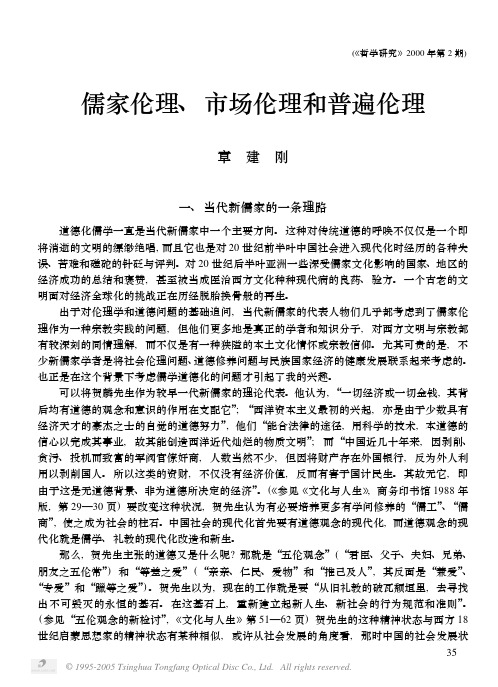
(《哲学研究》2000年第2期)儒家伦理、市场伦理和普遍伦理章 建 刚一、当代新儒家的一条理路道德化儒学一直是当代新儒家中一个主要方向。
这种对传统道德的呼唤不仅仅是一个即将消逝的文明的缥缈绝唱,而且它也是对20世纪前半叶中国社会进入现代化时经历的各种失误、苦难和磋砣的针砭与评判。
对20世纪后半叶亚洲一些深受儒家文化影响的国家、地区的经济成功的总结和褒赞,甚至被当成医治西方文化种种现代病的良药、验方。
一个古老的文明面对经济全球化的挑战正在历经脱胎换骨般的再生。
出于对伦理学和道德问题的基础追问,当代新儒家的代表人物们几乎都考虑到了儒家伦理作为一种宗教实践的问题,但他们更多地是真正的学者和知识分子,对西方文明与宗教都有较深刻的同情理解,而不仅是有一种狭隘的本土文化情怀或宗教信仰。
尤其可贵的是,不少新儒家学者是将社会伦理问题、道德修养问题与民族国家经济的健康发展联系起来考虑的。
也正是在这个背景下考虑儒学道德化的问题才引起了我的兴趣。
可以将贺麟先生作为较早一代新儒家的理论代表。
他认为,“一切经济或一切金钱,其背后均有道德的观念和意识的作用在支配它”;“西洋资本主义最初的兴起,亦是由于少数具有经济天才的豪杰之士的自觉的道德努力”,他们“能合法律的途径,用科学的技术,本道德的信心以完成其事业,故其能创造西洋近代灿烂的物质文明”;而“中国近几十年来,因剥削、贪污、投机而致富的军阀官僚奸商,人数当然不少,但因将财产存在外国银行,反为外人利用以剥削国人。
所以这类的资财,不仅没有经济价值,反而有害于国计民生。
其故无它,即由于这是无道德背景、非为道德所决定的经济”。
(《参见《文化与人生》,商务印书馆1988年版,第29—30页)要改变这种状况,贺先生认为有必要培养更多有学问修养的“儒工”、“儒商”,使之成为社会的柱石。
中国社会的现代化首先要有道德观念的现代化,而道德观念的现代化就是儒学、礼教的现代化改造和新生。
那么,贺先生主张的道德又是什么呢?那就是“五伦观念”(“君臣、父子、夫妇、兄弟、朋友之五伦常”)和“等差之爱”(“亲亲、仁民、爱物”和“推己及人”,其反面是“兼爱”、“专爱”和“躐等之爱”)。
借鉴儒家文化 建立有效商业伦理体系,中山大学吴柏林教授,广告策划:实务与案例,机械工业出版社,2010年版,
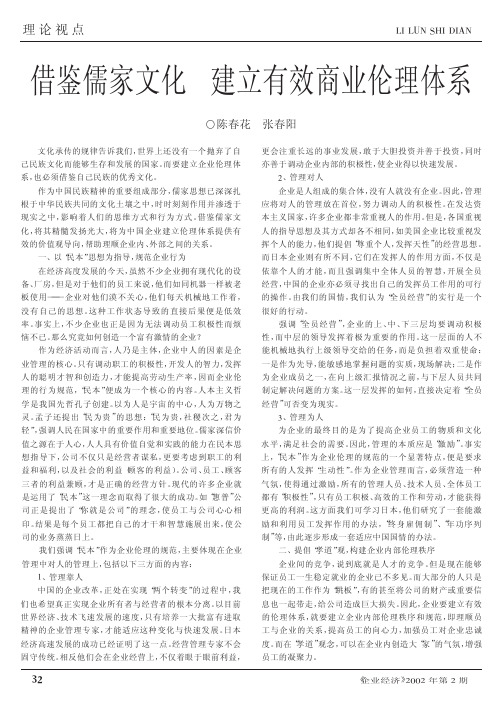
#$#%&’($)$*&理论视点文化承传的规律告诉我们,世界上还没有一个抛弃了自己民族文化而能够生存和发展的国家。
而要建立企业伦理体系,也必须借鉴自己民族的优秀文化。
作为中国民族精神的重要组成部分,儒家思想已深深扎根于中华民族共同的文化土壤之中,时时刻刻作用并渗透于现实之中,影响着人们的思维方式和行为方式。
借鉴儒家文化,将其精髓发扬光大,将为中国企业建立伦理体系提供有效的价值观导向,帮助理顺企业内、外部之间的关系。
一、以“民本”思想为指导,规范企业行为在经济高度发展的今天,虽然不少企业拥有现代化的设备、厂房,但是对于他们的员工来说,他们如同机器一样被老板使用———企业对他们漠不关心,他们每天机械地工作着,没有自己的思想。
这种工作状态导致的直接后果便是低效率。
事实上,不少企业也正是因为无法调动员工积极性而烦恼不已。
那么究竟如何创造一个富有激情的企业?作为经济活动而言,人乃是主体,企业中人的因素是企业管理的核心。
只有调动职工的积极性,开发人的智力,发挥人的聪明才智和创造力,才能提高劳动生产率,因而企业伦理的行为规范,“民本”便成为一个核心的内容。
人本主义哲学是我国先哲孔子创建。
以为人是宇宙的中心,人为万物之灵。
孟子还提出“民为贵”的思想:“民为贵,社稷次之,君为轻”,强调人民在国家中的重要作用和重要地位。
儒家深信价值之源在于人心,人人具有价值自觉和实践的能力在民本思想指导下,公司不仅只是经营者谋私,更要考虑到职工的利益和福利,以及社会的利益(顾客的利益)。
公司、员工、顾客三者的利益兼顾,才是正确的经营方针。
现代的许多企业就是运用了“民本”这一理念而取得了很大的成功。
如“惠普”公司正是提出了“你就是公司”的理念,使员工与公司心心相印。
结果是每个员工都把自己的才干和智慧施展出来,使公司的业务蒸蒸日上。
我们强调“民本”作为企业伦理的规范,主要体现在企业管理中对人的管理上,包括以下三方面的内容:+、管理靠人中国的企业改革,正处在实现“两个转变”的过程中,我们也希望真正实现企业所有者与经营者的根本分离。
“以德治国”与广告伦理,中山大学吴柏林教授,广告策划:实务与案例,机械工业出版社,2010年版
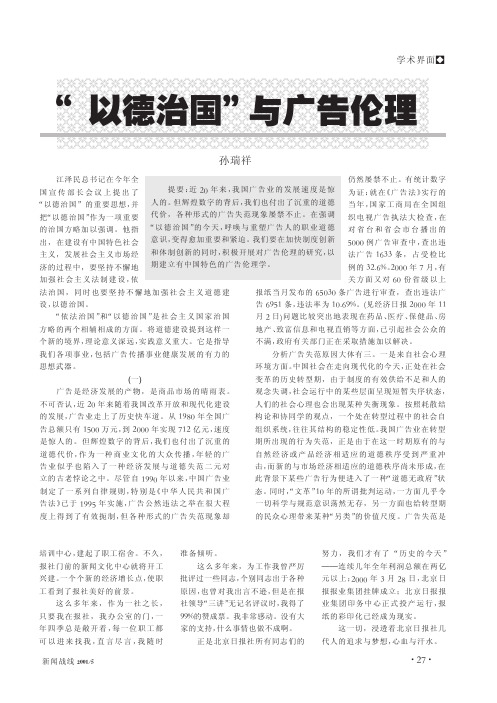
#" 年代末全国只有 $" 余家专业广告公司、数千名 广 告从业者,如今已是 # 万余广告经营单位、 %& 万从业
大军。来 势 迅 猛 的 商 品 经 济 大 潮 , 使尚未做好充分准 备的广告 人 匆 忙 上 阵 , 难免出现一些不适症。一是表 现 在 正 规 广 告 教 育 中 。 虽 然 自 $’() 年 以 来 我 国 大 陆 专、 本科广告教育方兴未艾, 但却普遍存在着重 “器” 轻 “道” 的教育 思 想 偏 失 , 由 此 导 致 广 告 的 技 法 传授 与 职 业素养培训的畸重畸轻,广告伦理教育没有受到应有 的重视。 二是表现在人才录用标准方面。 一些广告招聘 单位片面强调应聘者的职业背景和社会关系,重业绩 指标, 轻德性表现, 在客观上为滋生急功近利的不良职 业心态提供了生存土壤。三是由于某些以偏概全的社 会评价。 在不少人看来, 广告职业的社会声望不高, “广 告无学”的偏见仍大有市场,这种并非公正的社会舆 论, 对广告人自觉铸造职业荣誉感, 无疑会构成某种心 理伤害, 导致非良性社会互动行为的产生。 三是来自行业内部运行机制方面。如果说大环境 中的不利 因 素 , 还不能成为我们广告行为中某些道德 缺失的理 由 和 借 口 , 或至少这些因素尚构不成对广告 道德大厦 建 构 的 直 接 威 胁 , 而发生在我们行业内部的 “集体无 意 识 ” 现 象 , 则 是 一 种 最 具 破 坏 力 的 道 德 自 虐。症状 之 一 是 一 些 广 告 制 播 机 构 , 唯广告主意志行 事, 自动 放 弃 法 规 原 则 。 症 状 之 二 是 一 些 广 告 发 布 机 构将版面、 时段等媒介资源一 “包 ” 了之, 任由承包代 理公司随心所欲地经营。随着电视制片人或栏目主持 人制的闪亮登场, “出 售 ” 时段、 版面现象更是一发而 不可收。症状之三是一些媒介机构或广告公司内部各 自为政、 多头经营, 个别新闻记者也参与其间大搞有 偿新闻。症状之四是一些权力机构审查监管机制不健 全或形同虚设, 客观上形成了监管上的 “盲点” 。
中国古代优秀的商业伦理精神,中山大学吴柏林教授,广告策划:实务与案例,机械工业出版社,2010年版,绝密教学
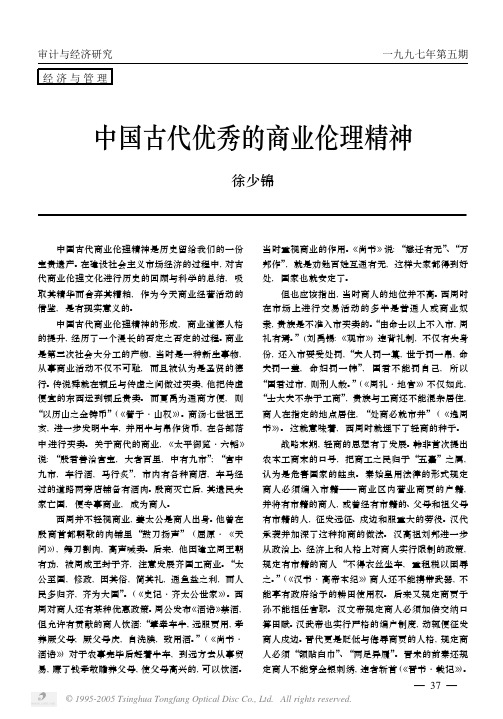
审计与经济研究一九九七年第五期经济与管理中国古代优秀的商业伦理精神徐少锦 中国古代商业伦理精神是历史留给我们的一份宝贵遗产。
在建设社会主义市场经济的过程中,对古代商业伦理文化进行历史的回顾与科学的总结,吸取其精华而舍弃其糟粕,作为今天商业经营活动的借鉴,是有现实意义的。
中国古代商业伦理精神的形成,商业道德人格的提升,经历了一个漫长的否定之否定的过程。
商业是第三次社会大分工的产物,当时是一种新生事物,从事商业活动不仅不可耻,而且被认为是圣贤的德行。
传说舜就在顿丘与传虚之间做过买卖,他把传虚便宜的东西运到顿丘贵卖。
而夏禹为通商方便,则“以历山之金铸币”(《管子・山权》)。
商汤七世祖王亥,进一步发明牛车,并用牛与帛作货币,在各部落中进行买卖。
关于商代的商业,《太平御览・六韬》说:“殷君善治宫宝,大者百里,中有九市”;“宫中九市,车行酒,马行炙”,市内有各种商店,车马经过的道路两旁店铺备有酒肉。
殷商灭亡后,其遗民失家亡国,便专事商业,成为商人。
西周并不轻视商业,姜太公是商人出身。
他曾在殷商首都朝歌的肉铺里“鼓刀扬声”(屈原・《天问》),舞刀割肉,高声喊卖。
后来,他因建立周王朝有功,被周成王封于齐,注意发展齐国工商业。
“太公至国,修政,因其俗,简其礼,通鱼盐之利,而人民多归齐,齐为大国”。
(《史记・齐太公世家》)。
西周对商人还有某种优惠政策。
周公发布《酒诰》禁酒,但允许有贡献的商人饮酒:“肇牵车牛,远服贾用,孝养厥父母;厥父母庆,自洗腆,致用酒。
”(《尚书・酒诰》)对于农事完毕后赶着牛车,到远方去从事贸易,赚了钱孝敬赡养父母,使父母高兴的,可以饮酒。
当时重视商业的作用。
《尚书》说:“懋迁有无”、“万邦作”,就是劝勉百姓互通有无,这样大家都得到好处,国家也就安定了。
但也应该指出,当时商人的地位并不高。
西周时在市场上进行交易活动的多半是普通人或商业奴隶,贵族是不准入市买卖的。
“由命士以上不入市,周礼有焉。
”(刘禹锡:《观市》)违背礼制,不仅有失身份,还入市要受处罚,“夫人罚一纂,世子罚一帛,命夫罚一盖,命妇罚一帏”,国君不能罚自己,所以“国君过市,则刑人赦。
广告及其伦理问题探析,中山大学吴柏林教授,广告策划:实务与案例,机械工业出版社,2010年版

从广告涉及的对象讲构成广告利益有三个基本 因素 :广告主体 、广告客体 、广告环境 。广告主体是 指策划发布广告的单位 、集体或个人 ;广告客体指广 告的接受者或影响者 ,即消费者或潜在消费者 ;广告 环境指广告运作的社会环境 。现代广告一般推行代 理制 ,广告主体一般又包括广告主 (厂家或个人) 、广 告经营者 (广告公司) 、广告发布者 (信息传播媒体) 。 由上可以看出 ,广告利益关系首先是广告主经营者 、 发布者之间的利益关系 ,它关系到广告行为的出台 和广告利益的成立 ,是基本利益关系 。其次是广告 主体与客体间的利益关系 。广告主的目的是鼓动消 费者购买物品 ,使其接受观念 ,而客体必须根据自己 需求和好恶作出购买与不购买 、接受和不接受的最 终选择 ,以及对自己的选择作出事后利益判断 。再 次是广告主体与社会环境之间利益关系 。广告是广 告主通过付费方式达到取得经济利润或传播信息目 的的手段 ,同时也体现了经营者的价值观 ,但是这只 是一种主观行为 ,广告最终会起到怎样的社会功能 , 造成有益还是无益社会的后果却是客观的 ,这会由 公众做出广告社会价值的评判 。最后广告利益关系 还体现为广告主与广告主 (企业与企业) 、经营者与 经营者的利益关系 。优胜劣汰的市场规则 、自负盈 亏的企业制度激活了企业经营 ,同业竞争更加激烈 , 广告大战早已司空见惯 ,每个企业都有了相对独立 的利益要求和利益支配权 。
市场经济的一种支持性资源,中山大学吴柏林教授,广告策划:实务与案例,机械工业出版社,2010年版,绝密教学资
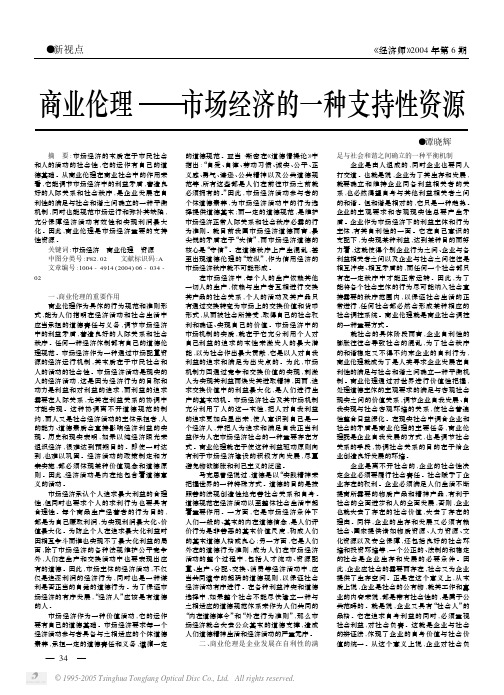
商业伦理———市场经济的一种支持性资源●谭晓辉 摘 要:市场经济的本质在于市民社会和人的活动的社会性,它的运作有自己的道德基础。
从商业伦理在商业社会中的作用来看,它能调节市场经济中的利益矛盾,营造良好的人际关系和社会秩序,是企业发展在自利性的满足与社会和谐之间确立的一种平衡机制,同时也能规范市场运行和弥补其缺陷,充分保障经济活动有效性和实现利润最大化。
因此,商业伦理是市场经济重要的支持性资源。
关键词:市场经济 商业伦理 资源中图分类号:F82.02 文献标识码:A 文章编号:1004-4914(2004)06-034-02一、商业伦理的重要作用商业伦理作为具体的行为规范和准则形式,能为人们指明在经济活动和社会生活中应当承担的道德责任与义务,调节市场经济中的利益矛盾,营造良好的人际关系和社会秩序。
任何一种经济体制都有自己的道德伦理规范。
市场经济作为一种通过市场配置资源的经济运行机制,其本质在于市民社会和人的活动的社会性。
市场经济活动是现实的人的经济活动,这是因为经济行为的目标和动力是利益和对利益的追求,而利益的追求需要在人际关系,尤其在利益关系的协调中才能实现。
这种协调离不开道德规范的制约,而人又是社会经济活动的主体承担者,人的能力、道德素质会直接影响经济利益的实现。
历史和现实表明,如果以纯经济眼光来组织经济,很难达到预期目的。
即使一时达到,也难以巩固。
经济活动的政策制定和方案实施,都必须体现某种价值观念和道德原则。
因此,经济活动是内在地包含着道德意义的活动。
市场经济承认个人追求最大利益的合理性,但同时也要求个人的求利行为也要具有合理性。
每个商品生产经营者的行为目的,都是为自己赚取利润,为实现利润最大化、价值最大化。
为防止个人在追求最大化利益时因相互争斗而谁也实现不了最大化利益的局面,除了市场经济的各种法规维护公平竞争外,人们在生产和交换活动中也要表现出应有的道德。
因此,市场主体的经济活动,不仅仅是追逐利润的经济行为,同时也是一种谋利是否正当的自觉的道德行为。
论商业广告的文化伦理责任,中山大学吴柏林教授,广告策划:实务与案例,机械工业出版社,2010年版,绝密教学资

收稿日期 1996年12月17日 商业经济与管理1997年第2期(杭州商学院)王剑峰 陈漭论商业广告的文化伦理责任 众所周知,广告是通过社会舆论的形式来实现其作用的,在大众传媒日益发达的今天。
商业广告已成为一种独特的社会文化,而且,这种社会文化正以其强大的冲击力影响着大众的心态和日常生活。
毫无疑问,不健康、不道德、不文明的广告倾向势必会给社会造成很大的危害。
广告的社会责任问题已成为一个越来越突出的社会问题,揭示商业广告所肩负的社会责任,唤醒商业企业和广告制作人的社会责任心正是本文的立意所在。
一、商业广告肩负着传递优良的民族传统的责任。
两千多年的中华文明史所孕育的传统文化渊远流长,博大精深,其影响在社会生活中无处不在。
比如:传统的商业活动中,具有广告宣传性质的店名、牌匾等无不深深打上传统文化的烙印。
象“全聚德”、“同仁堂”等百年老店,其店名本身就直接映射出儒家文化重仁、贵和的传统观念,而这些老店之所以流芳百世,业绩长存,与其店名所昭示的经营理念,文化底蕴是密不可分的。
根据广告心理的研究,人们通过广告在接受一种产品或服务的同时,也在接受一种文化观念,文化观念的认同,必然促进对广告所宣传的产品和服务的认同;同时广告的内容也会对文化风俗产生或好或坏的影响。
以上所例举的传统店名既暗合了传统文化的观念,又无形之中巩固倡导着传统的文化和美德。
反观现在的许多店名(包括商品品牌的宣传),超越民族文化的背景,脱离普通大众的生活,一味地求洋求怪,除了助长崇洋媚外,自贬民族文化的心理之外还能带来什么呢?!李政道教授在一次演讲中曾经说过:一个完全依赖祖先的民族是没有希望的,一个忘记过去的民族也是没有前途的。
现代化往往存在着一个与传统文化的嫁接问题,纵观世界各国的现代化,没有一个是在完全排斥和放弃自己传统文化的条件下实现的。
著名教授贾春峰先生曾提出过“文化力”的概念,认为在现代社会中,文化是推动经济和社会全面发展的内驱力,也是未来国际竞争中求胜的筹码,而文化力的一个重要组成部分就是传统文化,。
商业伦理塑造与企业家诚信,中山大学吴柏林教授,广告策划:实务与案例,机械工业出版社,2010年版,绝密教学资

!""!#$
ห้องสมุดไป่ตู้
中国人才
!"
每月聚焦
每月聚焦
魏 钧
郭春梅
商业伦理塑造 与企业家诚信
!!!!!! 我国消费者投诉案始终居高不下 ! 质量欺诈 " 价格 欺
诈 " 品牌欺诈成为三大社会问题 # 消费者投诉案件 !"#$ 年是 %&’! 件 !!""" 年上升到 ()&*+& 件 !!$ 年内消费者投 诉总数扩大了 "& 倍 $ 这个数字还不包括消费者受到损害 而不 予 投 诉 的 事 件 ! 约 有 $!,(- 的消 费 者 会 采 取 忍 受 态 度 $ +"").+""# 年 !全国发生重大劣质酒中毒案 # 起 ! 死亡 问题 & 的调查显示 ! 当问及 % 您对企业家精神如何理解时 &! 排在第一位的是 %追求利润最大化 &’10,2- ($ 这条西方经 济学 % 实 现 利 润 最 大 化 & 的 准则 ! 对 中 国 企 业 家 来 讲 ! 可 能是一个最大的误导 $ 在商业伦理匮乏和监督机制不健 全的情况下 ! 企业家一味追求经济利益 ! 不仅会给社会带 来混乱 ! 而且可能损害整个民族的声誉 $ 美国认证协会主 席立洛) 葛若认为 *% 中 国 商 业运 作 并 不 符 合 世 界 商 业标 准 $ 在中国的商业伦理中 ! 通常意识不到诸如产权 + 知识 等概念 &$ 零点调查公司一项 % 中国企业家的商业伦理指南 & 的 调查显示 ! 企业经营者只有 +0- 能较全面理解商业伦理 这一概念 $ 企业家对商业伦理的认识水平和深度 ! 直接影 企业商业信用危机的产生与企业家对商业伦理的忽 视密切相关 $ 在现实生活中 ! 企业家向往良好的商业伦理体系 ! 却 总是把不良道德风气归结为社会环境因素 ! 缺乏对于企 业家自身的道德内省 $ 一项 %中国企业经营者成长与发展 响着企业对商业伦理的理解和执行 $ 一项 % 企业经营者对 非道德行为采取态度 & 的调查结果告诉我们 ! 相当一部分 企业家对非道德行为采取了高度容忍的态度 ’ 见表 +($ 这 一现象验证了伯德 ’3456(% 经理人道德缄默 & 的观点 ! 他指 出一个典型事实 * 尽管经理人能意识到道德问题 ! 但他们
商业伦理建构的理论前提,中山大学吴柏林教授,广告策划:实务与案例,机械工业出版社,2010年版,绝密教学资料
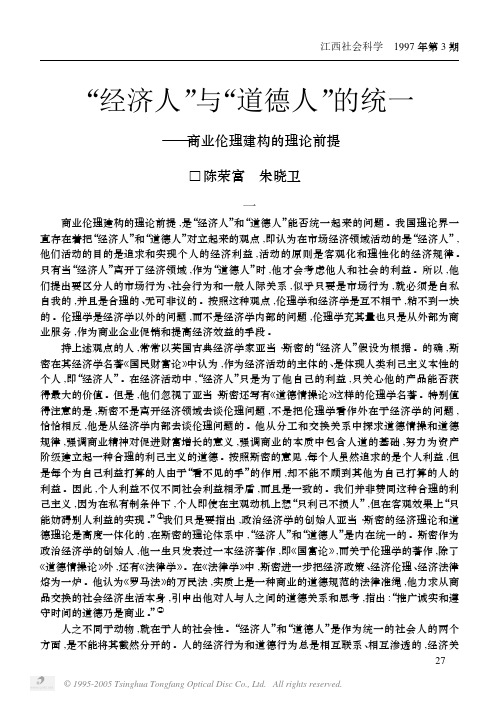
江西社会科学 1997年第3期“经济人”与“道德人”的统一———商业伦理建构的理论前提□陈荣富 朱晓卫 一商业伦理建构的理论前提,是“经济人”和“道德人”能否统一起来的问题。
我国理论界一直存在着把“经济人”和“道德人”对立起来的观点,即认为在市场经济领域活动的是“经济人”,他们活动的目的是追求和实现个人的经济利益,活动的原则是客观化和理性化的经济规律。
只有当“经济人”离开了经济领域,作为“道德人”时,他才会考虑他人和社会的利益。
所以,他们提出要区分人的市场行为、社会行为和一般人际关系,似乎只要是市场行为,就必须是自私自我的,并且是合理的、无可非议的。
按照这种观点,伦理学和经济学是互不相干,粘不到一块的。
伦理学是经济学以外的问题,而不是经济学内部的问题,伦理学充其量也只是从外部为商业服务,作为商业企业促销和提高经济效益的手段。
持上述观点的人,常常以英国古典经济学家亚当・斯密的“经济人”假设为根据。
的确,斯密在其经济学名著《国民财富论》中认为,作为经济活动的主体的、是体现人类利己主义本性的个人,即“经济人”。
在经济活动中,“经济人”只是为了他自己的利益,只关心他的产品能否获得最大的价值。
但是,他们忽视了亚当・斯密还写有《道德情操论》这样的伦理学名著。
特别值得注意的是,斯密不是离开经济领域去谈伦理问题,不是把伦理学看作外在于经济学的问题,恰恰相反,他是从经济学内部去谈伦理问题的。
他从分工和交换关系中探求道德情操和道德规律,强调商业精神对促进财富增长的意义,强调商业的本质中包含人道的基础,努力为资产阶级建立起一种合理的利己主义的道德。
按照斯密的意见,每个人虽然追求的是个人利益,但是每个为自己利益打算的人由于“看不见的手”的作用,却不能不顾到其他为自己打算的人的利益。
因此,个人利益不仅不同社会利益相矛盾,而且是一致的。
我们并非赞同这种合理的利己主义,因为在私有制条件下,个人即使在主观动机上想“只利己不损人”,但在客观效果上“只能妨碍别人利益的实现。
- 1、下载文档前请自行甄别文档内容的完整性,平台不提供额外的编辑、内容补充、找答案等附加服务。
- 2、"仅部分预览"的文档,不可在线预览部分如存在完整性等问题,可反馈申请退款(可完整预览的文档不适用该条件!)。
- 3、如文档侵犯您的权益,请联系客服反馈,我们会尽快为您处理(人工客服工作时间:9:00-18:30)。
广告策划—— ——实务与案例 吴柏林 广告策划——实务与案例
5
0.2 教学建议
0.2.1 教学目的 . . 通过本课程的学习,帮助学生从整体上把握广告 通过本课程的学习, 策划的基本原理与方法,了解广告运作的基本环 策划的基本原理与方法, 熟悉广告策划的基本策略与技巧, 节,熟悉广告策划的基本策略与技巧,为学生将 来从事广告策划工作,作好知识与技能上的准备. 来从事广告策划工作,作好知识与技能上的准备.
2010-3-20
广告策划—— ——实务与案例 吴柏林 广告策划——实务与案例
15
第8章 广告媒体策划
(1)了解广告媒体的分类方法,POP广告,DM广 )了解广告媒体的分类方法, 广告, 广 广告 媒体方案评估的主要内容; 告,媒体方案评估的主要内容; (2)理解影响媒体选择的因素,效果较佳的媒体组 )理解影响媒体选择的因素, 合形式,广告推出的时间安排; 合形式,广告推出的时间安排; (3)熟悉报纸,杂志,广播,电视,Internet广告 )熟悉报纸,杂志,广播,电视, 广告 的优缺点,媒体选择的基本原则; 的优缺点,媒体选择的基本原则; (4)掌握广告媒体的分类与作用,对广告媒体的八 )掌握广告媒体的分类与作用, 项评价指标. 项评价指标.
第1章 广告策划概论 章 第2章 广告调查研究 章 第3章 广告定位策略 章 第4章 广告目标与预算 章 第5章 广告策略规划 章 第6章 广告创意策略 章 第7章 广告文案写作 章 第8章 广告媒体策划 章 第9章 广告效果评估 章
研究生/MBA 研究生/MBA
2学时 4学时 4学时 4学时 6学时 6学时 4学时 4学时 2学时 36学时
2010-3-20
广告策划—— ——实务与案例 吴柏林 广告策划——实务与案例
2
0.1 关于本课程
广告策划是公共关系,市场营销,广告学,传播 广告策划是公共关系,市场营销,广告学, 新闻学,装潢设计等专业的必修课程. 学,新闻学,装潢设计等专业的必修课程.
2010-3-20
广告策划—— ——实务与案例 吴柏林 广告策划——实务与案例
2010-3-20
广告策划—— ——实务与案例 吴柏林 广告策划——实务与案例
10
第3章 广告定位策略
(1)了解品牌取名的程序与方法,商标设计的原则; )了解品牌取名的程序与方法,商标设计的原则; (2)理解市场细分的的概念,有效市场细分的五个 )理解市场细分的的概念, 特点,定位的四种错误; 特点,定位的四种错误; (3)熟悉广告定位的三大战略,十大战术; )熟悉广告定位的三大战略,十大战术; (4)掌握市场细分的概念,产品定位的概念,品牌 )掌握市场细分的概念,产品定位的概念, 的概念. 的概念.
2010-3-20
广告策划—— ——实务与案例 吴柏林 广告策划——实务与案例
13
第6章 广告创意策略
(1)了解詹姆斯韦伯 扬,李奥贝纳,罗瑟瑞夫, )了解詹姆斯 韦伯扬 李奥 贝纳,罗瑟 瑞夫, 韦伯 贝纳 瑞夫 大卫奥格威 威廉伯恩巴克 理查德伍甘 奥格威, 伯恩巴克, 伍甘, 大卫 奥格威,威廉 伯恩巴克,理查德 伍甘,艾 里斯和杰克特劳特等人关于广告创意的观点与 尔里斯和杰克 特劳特等人关于广告创意的观点与 里斯和杰克 方法. 方法. (2)理解广告创意的特点,广告创意的基本范畴, )理解广告创意的特点,广告创意的基本范畴, 形象与形象思维在广告创意中的作用; 形象与形象思维在广告创意中的作用; (3)熟悉联想的四个基本形态,产生创意的过程, )熟悉联想的四个基本形态,产生创意的过程, 广告创意方法; 广告创意方法; (4)掌握创意的概念与特点,联想的概念,UPS的 )掌握创意的概念与特点,联想的概念, 的 含义. 含义.
2010-3-20
广告策划—— ——实务与案例 吴柏林 广告策划——实务与案例
4
0.1.2 教材适应对象
在校本,专科学生与研究生.可作为广告学,市 在校本,专科学生与研究生.可作为广告学, 场营销学,公共关系学, 场营销学,公共关系学,广告设计等学科的专业 基础课教材,新闻传播,企业管理,经济管理, 基础课教材,新闻传播,企业管理,经济管理, 电子商务,艺术(装潢) 电子商务,艺术(装潢)设计等学科的专业选修 课教材或参考书. 课教材或参考书. 广告公司,公共关系公司,文化传播机构,营销 广告公司,公共关系公司,文化传播机构, 策划机构,政府宣传部门中从事广告策划, 策划机构,政府宣传部门中从事广告策划,营销 传播,宣传推广工作的专业人士. 传播,宣传推广工作的专业人士. 广大广告策划与创意的爱好者. 广大广告策划与创意的爱好者.
8
第1章 广告策划概论
(1)了解广告的直接功能与间接功能,广告策划的 )了解广告的直接功能与间接功能, 大致内容,整合营销传播的几个发展阶段; 大致内容,整合营销传播的几个发展阶段; (2)理解整合营销传播的两个特性,广告活动的主 )理解整合营销传播的两个特性, 要构成要素,整合营销传播基于消费者的方法; 要构成要素,整合营销传播基于消费者的方法; (3)熟悉广告策划的七个核心内容,整合营销传播 )熟悉广告策划的七个核心内容, 方案的实施的五种方法; 方案的实施的五种方法; (4)掌握广告的概念,整合营销传播的概念. )掌握广告的概念,整合营销传播的概念.
教材 吴柏林.广告策划.北京:机械工业出版社2010. 03 吴柏林.广告策划.北京:机械工业出版社2010.
2010-3-20
广告策划—— ——实务与案例 吴柏林 广告策划——实务与案例
1
前
言
0.1 关于本课程 0.1.1 教材编写宗旨 0.1.2 教材适应对象 0.2 教学建议 0.2.1 教学目的 0.2.2 前期需要掌握的知识 0.2.3 课时分布建议 0.3 网上学习支持与资源共享
2010-3-20
广告策划—— ——实务与案例 吴柏林 广告策划——实务与案例
16
第9章 广告效果评估
(1)了解广告社会心理效果的分析的侧重面; )了解广告社会心理效果的分析的侧重面; (2)理解广告效果的五个特性; )理解广告效果的五个特性; (3)熟悉广告效果的调查方法; )熟悉广告效果的调查方法; (4)掌握评估广告效果的几个重要指标. )掌握评估广告效果的几个重要指标.
2010-3-20
广告策划—— ——实务与案例 吴柏林 广告策划——实务与案例
6
0.2.2 前期需要掌握的知识
市场营销学,消费心理学,广告学原理等相关知 市场营销学,消费心理学, 识.
2010-3-20
广告策划—— ——实务与案例 吴柏林 广告策划——实务与案例
7
0.2.3 课时分布建议
教学内容
2010-3-20
广告策划—— ——实务与案例 吴柏林 广告策划——实务与案例
17
说
明:
(1)在课时安排上,对于MBA 36个学时即可;相 )在课时安排上,对于 个学时即可; 个学时即可 关专业本科生与专科生是根据54个学时安排的 个学时安排的. 关专业本科生与专科生是根据 个学时安排的. (2)讨论,案例分析等已经包括在各章的教学安排 )讨论, 之中. 之中. (3)关于教学的目标描述分别为:"了解","理 )关于教学的目标描述分别为: 了解" 熟悉" 掌握" 解","熟悉"与"掌握",这是一个由浅入深 的过程,对学生的要求也是一个渐进提高的过程. 的过程,对学生的要求也是一个渐进提高的过程.
3
0.1.1 教材编写宗旨
本书承接"柏林营销广告系列"的一贯风格,充 本书承接"柏林营销广告系列"的一贯风格, 分注意广告策划教学的综合性与实用性. 分注意广告策划教学的综合性与实用性.在教材 行文上,力争做到提纲挈领,要言不烦. 行文上,力争做到提纲挈领,要言不烦.在语言 表述上,力争做到自然,准确,简练, 表述上,力争做到自然,准确,简练,尽可能使 用广告人喜闻乐见的语言, 用广告人喜闻乐见的语言,尽量避免学究气和华 而不实. 而不实.案例教学与互动式教学历来是广告策划 课程的鲜明特色之一, 课程的鲜明特色之一,通过精选案例分析与研究 引导学生更快地进入学习状态, 引导学生更快地进入学习状态,真正以广告人的 身份进入广告策划的学习. 身份进入广告策划的学习.
2010-3-20
广告策划—— ——实务与案例 吴柏林 广告策划——实务与案例
14
第7章 广告文案写作
(1)了解广告文案的体式,广告文案撰稿人经常会 )了解广告文案的体式, 犯的错误; 犯的错误; (2)理解广告文案的立意,写作规范与要求; )理解广告文案的立意,写作规范与要求; (3)熟悉广告文案的写作过程,广告文案构思,的 )熟悉广告文案的写作过程,广告文案构思, 内容,广告文案,的构思方法, 内容,广告文案,的构思方法,广告文案修改中 的自我检核方法; 的自我检核方法; (4)掌握广告文案的概念标题,正文,广告语,随 )掌握广告文案的概念标题,正文,广告语, 文的写作规范或要求. 文的写作规范或要求.
2010-3-20
广告策划—— ——实务与案例 吴柏林 广告策划——实务与案例
11
第4章 广告目标与预算
(1)了解营销目标的概念,DAGMAR法可能存在的 )了解营销目标的概念, 法可能存在的 问题; 问题; (2)理解广告目标的意义,科利关于广告传播任务 )理解广告目标的意义, 的等级模型, 的等级模型,DAGMAR法对于制定广告促销活动 法对于制定广告促销活动 的计划的重要性; 的计划的重要性; (3)熟悉营销的具体目标,广告预算时考虑的因素, )熟悉营销的具体目标,广告预算时考虑的因素, 广告预算的方法,广告预算分配的方法; 广告预算的方法,广告预算分配的方法; (4)掌握广告目标的概念,广告预算的概念, )掌握广告目标的概念,广告预算的概念, DAGMAR的含义. 的含义. 的含义
